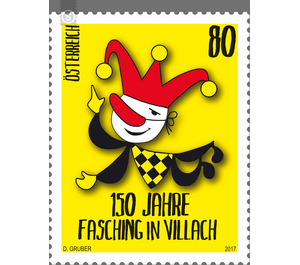150 years - Austria / II. Republic of Austria 2017 - 80 Euro Cent
Theme: Calender
| Country | Austria / II. Republic of Austria |
| Issue Date | 2017 |
| Face Value | 80.00 |
| Edition Issued | 175,000 |
| Perforation | 13¾ x 14¼ |
| Printing Type | offset |
| Stamp Type | Commemorative |
| Item Type | Stamp |
| Chronological Issue Number | 2658 |
| Chronological Chapter | OOS-OE2 |
| SID | 213678 |
| Dimensions | 42.00 x 33.00 |
| In 75 Wishlists | |
On Shrove Tuesday 1867 in the Carinthian town of Villach the carnival ended with a "successful Corso ride" with hundreds of masked participants - this was the birth of the famous Villach carnival. The stamp issue on the occasion of the 150th birthday shows the symbol of the Villach carnival guild: a little fool with a fool's cap. Today, the club consists of more than 200 active members who volunteer to organize carnival events throughout the year. At the beginning of the 20th century, it was the "Bauerngman Villach", which organized the Villach farmers' ball as a carnival event. The Bauerngman is still active as a charitable association in Villach and performs among other things, the Villach Kirchtag and other charitable events. In 1955 the Villach Carnival finally became Carnival, and as the carnival enthusiasm of the Villachers grew and the first "Faschingssessions" were held, the organization of the Villach carnival was broken out of the Bauerngman Villach and a separate club was founded. The highlight of the carnival season is the big parade on Carnival Saturday, in which some 150 carnival groups with more than 3,000 disguised fools and jesters participate. The most beautiful masks are judged and awarded in different categories by a jury. All of Villach is involved in the mad rush on this day, people are disguised everywhere and thousands of visitors come to watch the spectacle. In addition to the parade, the carnival sessions are a fixture of every carnival. Legendary protagonists such as the "Apotheker" - now retired -, "Noste" or the "EU farmer" comment on the current political situation, the guard dances and the court orchestra plays. Every year a couple of princes and a couple of princesses are appointed, and for 50 years there have also been some children's carnival sessions.


